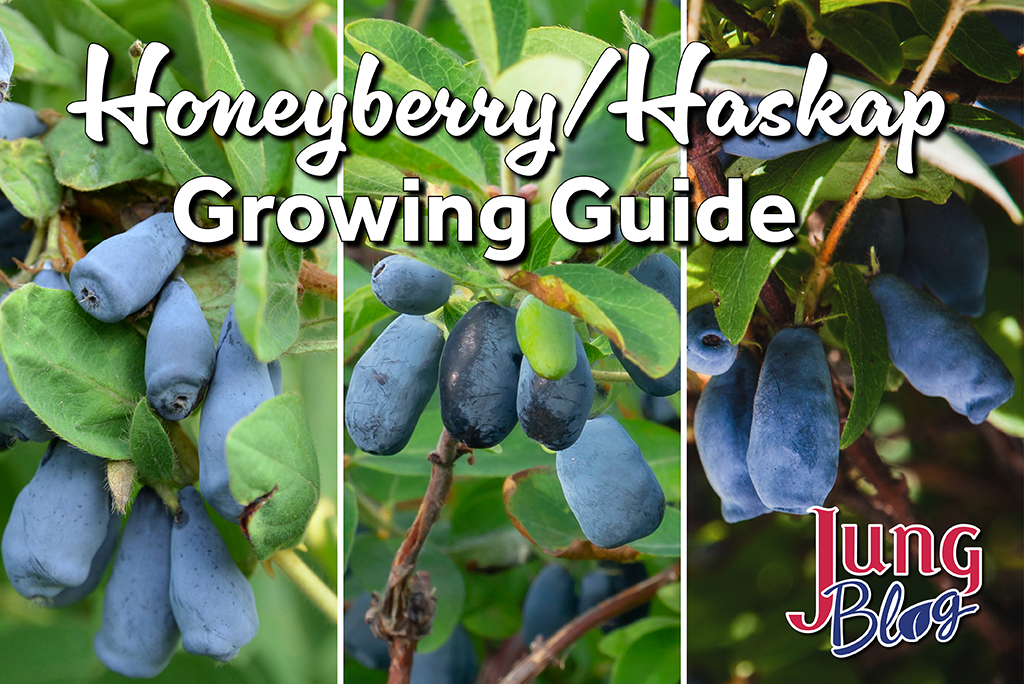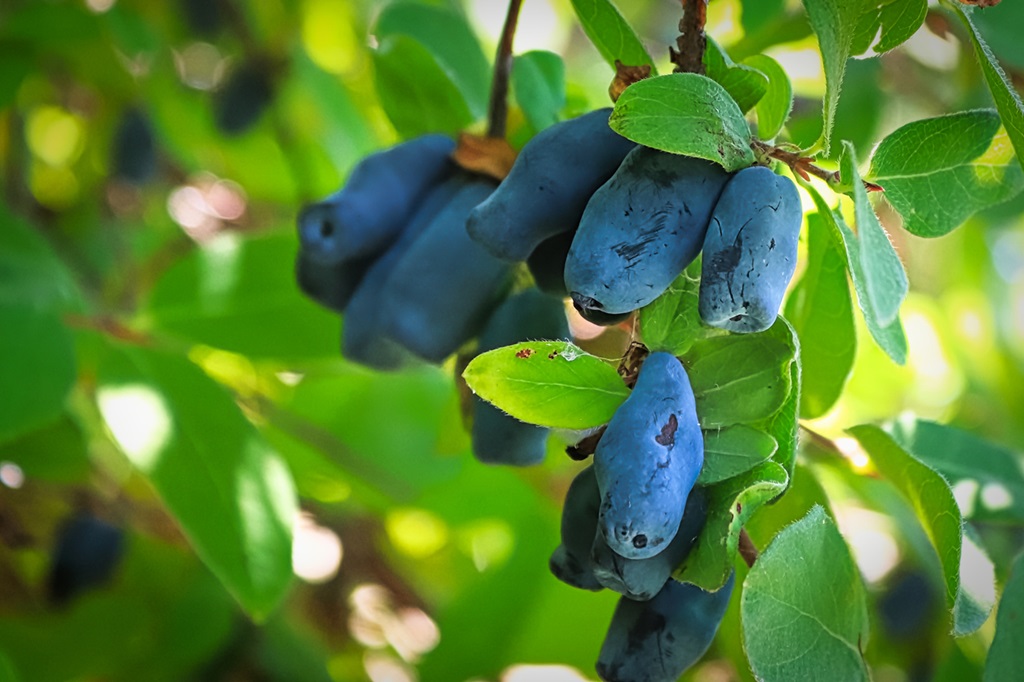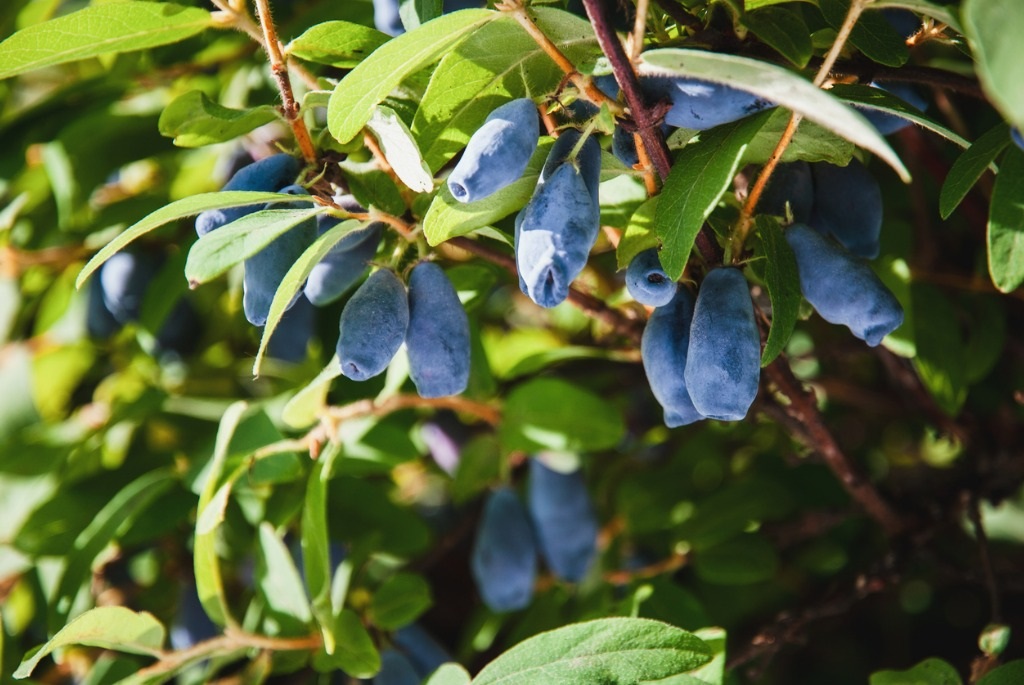
If you’re looking for a hardy, easy-to-grow plant that brings delicious, blueberry-like fruits to your garden, look no further than Honeyberry, also known as Haskap. These remarkable bushes can withstand frigid temperatures down to -40°F, making them a perfect choice for colder climates. They bloom in March with small, white, slightly fragrant flowers, setting the stage for fruit ripening about two weeks before strawberries. The berries are similar in color and flavor to large blueberries and are a delightful treat for early-season harvesting. With few pest or disease issues, these plants are low-maintenance and thrive with little fuss. While they prefer partial shade in hot summer regions, they’ll happily grow in full sun in northern states.
Honeyberry Quick Tips

- These edible blue honeysuckles are native to Northern California, the Pacific Northwest, Canada, Russia, and Japan.
- It is not dependent on low soil acidity like blueberry plants.
- Suitable for USDA zones 3-8. (See additional notes about cultivars below)
- All varieties require cross-pollination.
- First crop harvests are usually 1-2 years from planting.
Honeyberry Planting Tips

Bare Root Plants
- Soak roots for 8 to 24 hours before planting.
- Plant within 72 hours after receiving. Dormant plants require cold weather establishment.
- Plant in full sun, in well-draining soil amended with ample organic material.
- Dig a large hole 2-3 times the size of the rootball.
- Plant with the top of the rootball no more than 1 inch below the natural soil grade, ensuring the crown remains above the soil surface.
- Remove grass or competing weeds from a 2-foot circumference around the new plants.
- Top-dress over the root zone with 2-3 inches of fresh compost or mulch.
- Immediately after planting, tip prune all stems back by 1/3 to 1/2.
Potted Plants
- No root soaking is required; however, harden plants off for 7-10 days before planting to acclimate plants to the local conditions.
- Follow the other planting instructions above.
- Protect newly planted Honeyberries from hard frosts by covering them with frost cloth, burlap, or home linens.
Frost & Transplant Shock
- Cut stems back by 1/3 to 1/2
- This will initiate new bud and shoot growth in 6-8 weeks or sooner
Planting Pattern
- All varieties require cross-pollination
- An alternating grid planting pattern or planting in rows of alternating varieties with similar bloom periods will ensure the best pollination.
Watering
- The watering rule of thumb is 1 inch of water per week per plant, which equates to approx. 2.5-3 gallons of water every 2-3 days through the growing season.
- Do not rely on or consider rain events as they are too unreliable and sporadic.
- Honeyberries do not tolerate heavy, wet clay soils or standing water.
- Amend soils well before planting to avoid long-term issues or slow deterioration.
Honeyberry Plant Care

- Allow plants to grow to full size for several years before pruning.
- Fruits are produced on 1-year-old wood.
- Prune using thinning cuts during dormancy to remove damaged, diseased, and older branches and encourage an open growth habit that allows sunlight to penetrate and provides air circulation.
- Never prune branch tips. Flowers and fruits are produced at the ends of branches.
- Fertilize in early spring with 1/2 dose and another 1/2 again after harvest with 10-10-10 all-purpose or an organic with 3-5-3 formulation.
- Top-dressing with fresh compost/aged manure blend in early spring and mid-summer is also beneficial.
- Most honeyberries are susceptible to powdery mildew, especially early in the season. Wettable sulfur fungicide has shown to be the best preventative, as have other proper cultural sanitation methods.
Honeyberry Cultivars & Pollination Details

The following cultivars were bred by the University of Saskatchewan and chosen for their large, firm fruit with superb flavor and fast growth rate. The Tundra was selected for its excellent flavor, shape, and size, with enough firmness to make it a good keeper. Suitable for commercial machine harvest, you can plant with Aurora, Borealis, Honey Bee, or Berry Blue. These plants quickly reach a height of 3-5 feet and begin bearing fruit just 1 to 2 years after planting, making them a rewarding addition to any garden.
Blue Moon™ & Blue Velvet™
- Two Russian Honeyberry varieties are shipped as 1-2 foot well-rooted bare-root plants.
- These varieties are best for planting in 3a to 4b colder zones.
- Pre-soak roots before planting for at least 8 hrs.
- Prune stems back by at least 1/3 immediately after planting to encourage new growth.
- Plants mature at 3-4 feet high & wide.
- Best fruit yields come from plantings of 5-8 plants spaced 4-6 feet apart in alternating single rows or in a grid.
Canadian Honeyberries
- Canadian varieties and Berry Blue™ shipped as small, greenhouse-grown potted plants.
- Most suitable for USDA zones 4b-8a. (The warmer the climate, the more disease susceptibilities can occur).
- Harden off for 7-10 days before planting. After planting in spring, protect plants if frost threatens.
- If plants are still entirely dormant, they can be planted at any time.
- Plant size varies by cultivar, but it typically ranges from 3 to 6 ft. and begins bearing fruit 2-3 years after planting.
- At least two different varieties with similar bloom periods are needed for proper cross-pollination.
- For best fruit production, plant at least 5-8 plants with a spacing of 6 to 8 ft. by alternating variety or in a grid pattern.
Early-Season Blooming Types
- Aurora is a long, mid-early-season flowering.
- It should be planted with other early or mid-types, such as Honey Bee, Tundra, Berry Blue, or Borealis.
Mid- to Late-Season Blooming Types
- Boreal Blizzard, Boreal Beast, and Boreal Beauty are all mid- to late-blooming and good partners for cross-pollination.
- Boreal Beauty is the best late-blooming cultivar to pair with Russian varieties for potential cross-pollination.

Planting and caring for Honeyberry, or Haskap, is rewarding with the proper techniques. With these care guidelines, your Honeyberries will thrive, providing you with a bountiful and delicious harvest.
Other Recommended Reading

- Bee Gardens: Cultivating Pollinator Paradises
- Shade Garden Design Ideas
- Easy Ways To Create A Mindful Garden From Scratch
- Create A Cottage Garden
- How to Create a Rain Garden
At Jung Seed Co, we strive to be your go-to guide for all your gardening needs. Our YouTube channel, The Garden Doctor by Dick Zondag, is where he provides gardening tips for all levels of gardeners. When you need reliable gardening advice, turn to the trusted experts at Jung.
View our new catalog online or browse our website for your gardening favorites. Sign up for our weekly email to receive info on new products, exclusive deals, and specials. Join our Facebook page to discuss all things gardening!